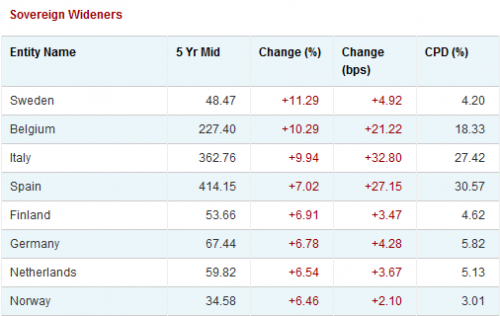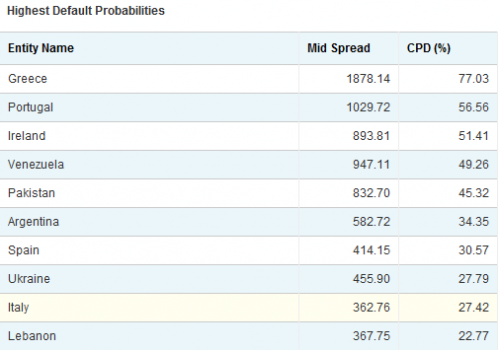Spain, Italy, Belgium yields now under attack
I know its not fashionable to defend the euro zone elites. But when I outlined what the European Greek debt deal means, I said “There are many more steps to take, but this is a step in the right direction…I am pretty happy with where we have got to on the liquidity side of things” – meaning Greece, Ireland and Portugal had been taken care of (for now) until their budget cuts fail to meet expectations. And indeed, Greece, Ireland and Portugal have been backstopped and their yields are no longer shooting up. So, on one level, the Europeans’ last solution has been effective.
However, the European debt crisis has now widened to Spain, Italy and Belgium. Spreads in those nations widened to euro-era record levels, even as 10-yr Treasury yields slumped to year lows and 10-year Gilt yields slumped to record lows.
The juxtaposition is due entirely to the lack of currency sovereignty in Euroland and the liquidity crisis that has resulted from this.
Notice that the big wideners in sovereign credit default swaps are all from Europe, as are the highest default probability sovereigns. (As an aside, Sweden’s presence there is worrying since they are not in the euro zone. Does this have to do with their property market?)
As I said a bit over a week ago:
My expectation is that Spain and Italy will be perceived as the new Ireland and Portugal, meaning they will now be stressed permanently – the spread to bunds will be permanently elevated at levels that are almost unsustainable for economic growth. The right way to deal with this is for the ECB (not the under-powered EFSF) to provide liquidity. Earlier, I suggested the ECB targeting the Italian-Bund spread at 200bps would be an effective way to go about this. But given the politics of the matter, that will never happen.
So we are going to get another crisis flare. What you need is a trigger for a gap up move in yields that would signal the next flaring of the crisis. The trigger and its timing are unknown, but the crisis they will precipitate is inevitable until the euro zone’s structural deficits are dealt with. As this is a rolling crisis, any gap up will also infect Belgium and France and potentially Austria.
My hope is that Europe moves to address the medium- and long-term issues before the crisis flares. However, I don’t anticipate they will.
The Europeans can’t catch a break. The crisis has already flared before they have had a legitimate opportunity to deal with the medium- and longer-term issues. Willem Buiter says the Europeans need a 2.5 trillion euro EFSF to deal with this. I think the EFSF is fatally flawed in that it depends critically on funds from the nations being bailed out. How many large nations are there in the euro zone which can backstop the periphery? Maybe 5 – Germany, France, Italy, Spain and the Netherlands (if you think 15 million people is large). With Italy and Spain at risk, it seems to me that the EFSF is done. So, forget about 2.5 trillion in funds. That’s not going to happen.
Source: CMA Market Data


I am surprised the Lebanon is in that list of likely defaults. It’s banking system escaped the financial crisis unscathed due to the high reserves requirements. Though that does not mean the government has been good. It will be one less problem for them to deal with.
As I expected Belgium is there. Depending on what it does to save its banks I think they could get through okay unless they do an Ireland and slowly bankrupt themselves. No mention of contagion hitting Belgium, yet. Though France will be joining them soon enough.